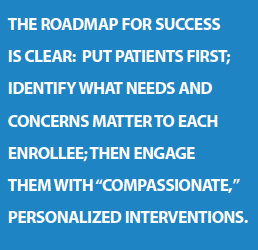 Patient-centricity is widely embedded into the mission statements and values of biopharma organizations. It gives purpose and urgency to efforts across research, development, and commercialization. Yet patient-centricity often is vaguely defined — making the goal hard to achieve. Teams striving for patient-centricity could use a roadmap.
Patient-centricity is widely embedded into the mission statements and values of biopharma organizations. It gives purpose and urgency to efforts across research, development, and commercialization. Yet patient-centricity often is vaguely defined — making the goal hard to achieve. Teams striving for patient-centricity could use a roadmap.
A workgroup involving advocates and caregivers recently published an article in BMJ Innovations that defines the concept of patient-centricity as: “Putting the patient first in an open and sustained engagement to respectfully and compassionately achieve the best experience and outcome for that person and their family."1 Below, we examine how to apply the principles of patient-centricity captured in this definition to the development and measurement of Patient Support Programs (PSPs), to help ensure better experiences and outcomes for patients on treatment.
Put the Patient First
A new prescription can trigger a cascade of processes managed by patient services teams, hub, and pharmacy partners. These groups are united in helping patients gain access to the medications they need, in as little time as possible. But too often, the byzantine routes of paperwork and approvals result in delays fulfilling a prescription or a barrage of phone calls to the patient’s home. These problems contribute to prescription abandonment, treatment discontinuation, and increased anxiety for the patient.
What can pharmaceutical companies do? “Putting the patient first" requires an understanding of the patient’s needs. While most brands offer some form of practical and financial support to expedite treatment starts, the key to driving long-term engagement and a better experience for patients is belief-based support that speaks to an individual’s real concerns. Effective PSPs leverage a program enrollment tool or survey at treatment initiation to identify what type of support a patient is looking for, or in need of.
Without adding a lot of complexity to a PSP or hub enrollment process, it’s possible to ask and assess:
How does the patient feel about their diagnosis and treatment plan?
What specific areas of concern do they have, and what do they want more information on?
Who can the patient turn to for help and information related to their specific concerns?
Once the patient needs and beliefs are understood, they can be addressed in forthcoming communications and interactions delivered through the PSP. This will lead to more meaningful content and a more patient-centric experience.
Create Relevant and Compassionate Communications
 Leveraging health psychology enhances the relevance and effectiveness of PSPs. Patient beliefs are known to be key factors influencing health behaviors, such as medication adherence or the pursuit of follow-up tests. Health psychology-driven research should be done early (e.g. pre-launch) to understand the drivers of patient behavior, and inform the development of PSP communications.
Leveraging health psychology enhances the relevance and effectiveness of PSPs. Patient beliefs are known to be key factors influencing health behaviors, such as medication adherence or the pursuit of follow-up tests. Health psychology-driven research should be done early (e.g. pre-launch) to understand the drivers of patient behavior, and inform the development of PSP communications.
Health psychology also indicates the types of interventions and content that will be most effective for changing behavior. For example, to drive adherence, patients may need an understanding of why the treatment is important to their care and long-term control of the condition. In these cases, disease education and tools to support effective doctor-patient dialogues can help patients commit to the treatment plan, as prescribed.
If patients feel stigmatized by their condition, they need different interventions to reduce negative feelings and provide reassurance. This could involve sharing patient stories, creating caregiver resources, or encouraging patients to access community support services. The key is matching the right content and the right intervention to the right patient.
Given that beliefs differ across individuals enrolling in a PSP, it’s also important to have a program that adapts to individual patient inputs and responses to the enrollment tool. Providing for personalization — as opposed to relying on a universal approach — demonstrates greater “respect and compassion" to program enrollees.
Define Clear Program Goals
 It is important to design PSPs around clear goals for patient support and behavior change, and reflect those goals in the measurement plan and key performance indicators (KPIs). BioPharma companies are, at heart, data-driven organizations, motivated by evidence of how well medicines and interventions work. If the goals of a PSP include delivering patient-centric support, it’s important to include metrics aligned with that purpose.
It is important to design PSPs around clear goals for patient support and behavior change, and reflect those goals in the measurement plan and key performance indicators (KPIs). BioPharma companies are, at heart, data-driven organizations, motivated by evidence of how well medicines and interventions work. If the goals of a PSP include delivering patient-centric support, it’s important to include metrics aligned with that purpose.
Patient Support Scorecards should include KPIs for each phase of the patient treatment journey — from patient enrollment, to communication effectiveness, and ultimately adherence. Each group of metrics forms a key step toward program and patient success:
1. Operational — These may include the completion of hub staff training programs, SOPs and contracts, and approval of promotional materials and content to assure resource readiness.
2. Engagement — These statistical measures track the volume, efficiency and productivity of PSP and PAP workflows (e.g. number of patients enrolled in PSP; number of PAs or BIs processed).
3. Patient Beliefs — These KPIs include patient feedback, satisfaction scores, as well as changes in patient beliefs compared to baseline measures (e.g. responses to enrollment tool at treatment initiation and at +6 months).
4. Adherence — Building upon the prior “steps" enables better adherence and persistency — an important, shared goal for the business and for key stakeholders invested in improving patient outcomes.
From one step to the next, KPIs indicate how well the program is working. Patient support programs that are initiated at the moment of prescription or hub engagement tend to see better enrollment. And higher program enrollment can support sustained patient engagement and changes in patient behavior.
It is important not to overlook Patient Belief metrics. These KPIs assess how well PSP materials and interventions address patient needs for information and support. Tools for collecting patient feedback, nurse feedback, and changes in beliefs can be used to gauge and optimize each program touchpoint — and ensure the overall PSP experience is positive. This group of metrics also provides the groundwork for better adherence and treatment outcomes, driven by positive beliefs and behaviors among program enrollees.
Drive Results with Patient-Centric PSPs
Atlantis Healthcare (AH) uses these principles of patient-centricity to develop PSPs that produce strong patient engagement and high adherence rates. In one example, AH created a PSP to help patients with a cardiovascular disease. Research was done to inform the program’s content; it showed that patients didn’t fully understand the condition and doubted the necessity of adding a new treatment on top of the standard of care. Based on these insights, the PSP content and touchpoints focused on driving patient beliefs in treatment necessity. AH provided new resources to support the doctor-patient dialogue at the moment of prescription, reinforcing the importance of treatment for long-term disease control. Ongoing communications also reinforced these messages and patients’ acceptance of their diagnosis. More than 85% of patients rated the PSP interventions as very meaningful and relevant. And after 8 months, we saw a 30% increase in prescription refills for PSP enrollees versus non-enrollees.
Another PSP we manage gives support to rare disease patients on an oral, self-administered therapy. AH developed a belief-based, multichannel program to assist patients in managing their care and finding emotional support. Specific tools were created to help patients establish and follow a consistent care routine, and learn from the experiences and best practices of other patients on the same treatment. Patients enrolled in the PSP showed >90% adherence to therapy after 1 year.
As these examples show, belief-based support and communications generate strong results and the desired patient behavior. PSPs enable teams to replicate these results at scale. The roadmap for success is clear: put patients first; identify what needs and concerns matter to each enrollee; then engage them with “compassionate," personalized interventions. This is a good way to demonstrate patient-centricity in patient services and commercialization.(PV)
Notes: 1 Yeoman G, Furlong P, Seres M, et al; Defining patient-centricity with patients for patients and caregivers: a collaborative endeavor; BMJ Innovations Published Online First: 24 March 2017. doi: 10.1136/bmjinnov-2016-000157
Atlantis Healthcare leverages health psychology to develop and deliver uniquely personalized healthcare solutions that drive sustained improvement in treatment adherence and patient self-management across disease states.
For more information, visit atlantishealthcare.com.


















